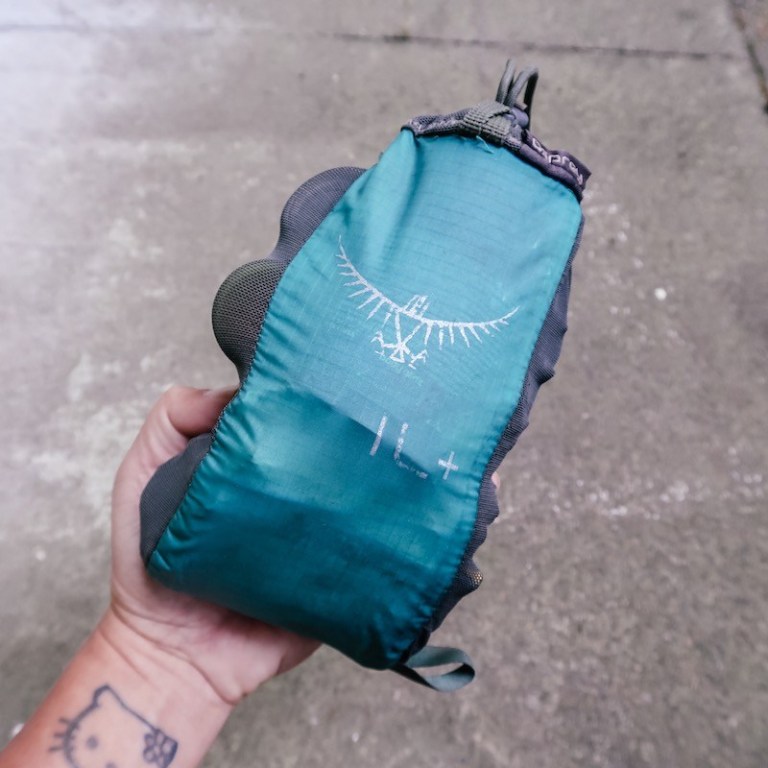
Having a first-aid kit in your pack while traveling in the backcountry is not something to either skip, scrimp on or overlook. Just ask anyone involved in Search and Rescue, the first people to arrive on scene when hikers and backpackers call for help. Like the 10 Essentials, having some sort of first-aid kit in your pack is a necessity. It’s like insurance – you might not need it every time you go outside, but when you find yourself in a situation where you do need it, you’re glad you have it. Having some sort of backcountry first-aid kit can literally save your (or another hiker’s) butt.
Over the last two years of thru-hiking the Pacific Crest Trail, I came across plenty of hikers who didn’t have a first-aid kit in their packs. They didn’t think having one was valuable or worth the weight. Many hikers feel this way until something happens – a sprained ankle, infected blisters, getting sick from untreated water, altitude sickness, falling into a patch of poison oak, open sores and wounds from a nasty fall, having an allergic reaction, etc.
While hiking the PCT, my backcountry first-aid kit has come to the rescue not only for myself, but also for other hikers. Last year, I gave my ankle brace to a hiker who injured his ankle within the first 100 miles on trail. I was able to help another hiker treat their blisters within the first few days of being on the PCT. There was even a member in my trail family who refused to treat his water. I was able to help him get into town a bit more comfortably with the prescription of Flagyl I had in my kit.
I’m a planner by nature, sometimes to a fault. I’d rather be over-prepared for a situation than not have anything at all, especially when I’m multiple days from the nearest road or trailhead. Putting together my own backcountry first-aid kit for my first PCT thru-hike was something new to me. When I originally started hiking, I purchased a pre-assembled Mountain Weekender First-Aid Kit from REI and carried it in my pack on every day hike. It weighed 1lb, 9oz and contained enough medical supplies for groups up to 6 people on a 1 to 7 day trip. Who did I think I was? Search and Rescue?
After attending a Backpacking Basics class at REI and getting a gear “shakedown” in class, I realized how overkill my first-aid kit was for day hiking. As I started planning my first PCT thru-hike, I knew there was no way I was going to carry my monstrous first-aid kit from Mexico to Canada. I had to downsize to a kit that made sense for me. After doing some research and talking to a few previous PCT thru-hikers, I decided to put together my own first-aid kit. Over the last couple of years, I’ve made some modifications.
The Progression of My Backcountry First-Aid Kit:
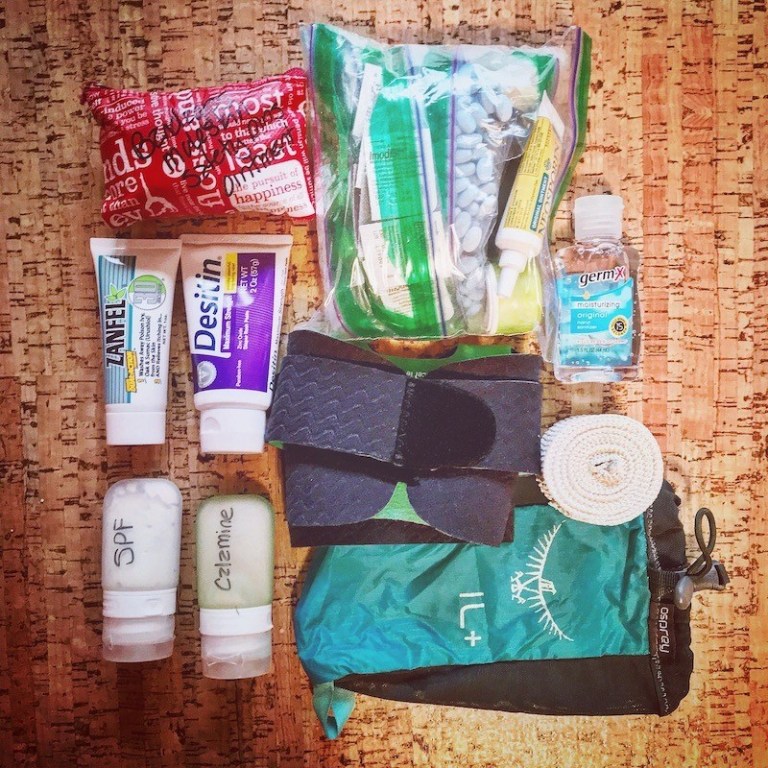
My Original First-Aid Kit Included:
1L Osprey Ultralight Stretch Stuff Sack
1 oz. Zanfel (A highly recommended poison oak treatment)
1 oz calamine lotion
0.5 oz. Neosporin
1 oz. Hand sanitizer
1 oz. SPF 50 sunscreen
2 oz. Desitin (for chafing)
1 oz. New Skin liquid bandage (for blisters)
Multiple sized Band-Aids
Multiple sized blister bandages/cushions
Antiseptic wipes x 2
Small packets of insect bite relief
Imodium (9 caplets)
Aleve (130 caplets) + humangear GoTubb container to store them in
Benadryl (24 tablets) + humangear GoTubb container to store them in
Pre-cut hot herbal patches (for aching muscles)
Pre-cut moleskin (blister care)
1 pair of latex gloves
1 Ace self-adhering elastic bandage
2 Safety pins
1 lightweight, adjustable ankle brace (Recommended by my doctor in case I sprain my ankle)
Flagyl for Giardia (Prescription Medication)
Diamox for altitude sickness (Prescription Medication)
Antibiotics for UTI (Prescription Medication)
Zithromax for sinus infection (Prescription Medication)
0.5 oz Kenalog topical ointment (Prescription ointment for poison oak)
I have no idea how much it weighed.
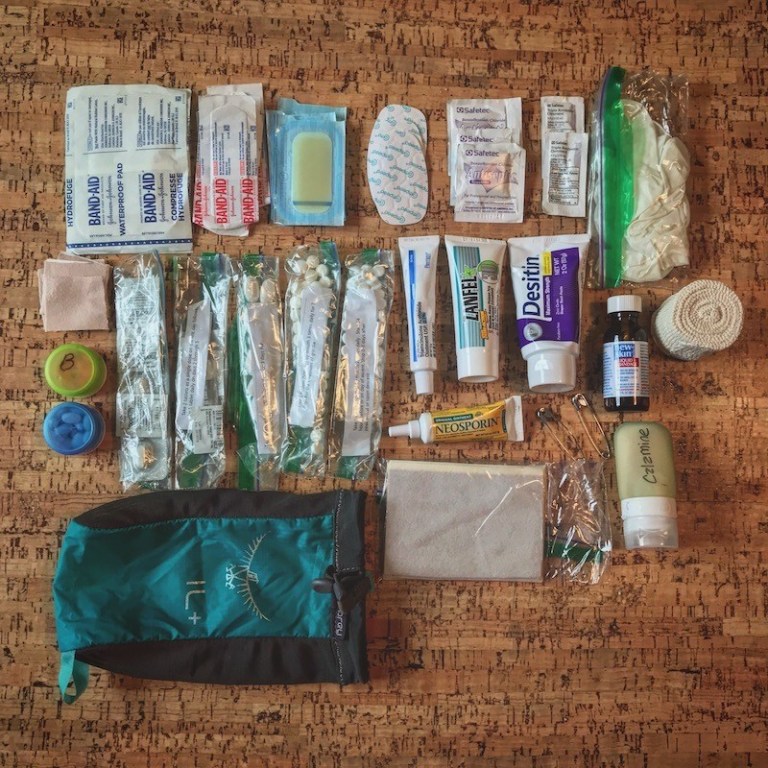
The First-Aid Kit I Started My First PCT Thru-Hike With:
1L Osprey Ultralight Stretch Stuff Sack
1 oz. Zanfel (A highly recommended poison oak treatment)
1 oz calamine lotion
0.5 oz. Neosporin
2 oz. Desitin (for chafing)
1 oz. New Skin liquid bandage (for blisters)
3 waterproof pad bandages
5 Band-Aids (regular size)
6 blister gel bandages
3 oval, textured blister bandages
8 small pre-cut pieces of self-adhesive moleskin
3 hot herbal patches, cut in half (for sore muscles)
1 Ace self-adhering elastic bandage
3 Antiseptic towelettes
2 – 0.9 g triple antibiotic ointment packets
Imodium (5 caplets)
Aleve (27 caplets) + humangear GoTubb container to store them in
Benadryl (24 tablets) + humangear GoTubb container to store them in
1 pair of latex gloves
Safety pins x 2
1 lightweight, adjustable ankle brace (Recommended by my doctor in case I sprain my ankle)
Flagyl for Giardia (Prescription Medication)
Diamox for altitude sickness (Prescription Medication)
Antibiotics for UTI (Prescription Medication)
Zithromax for sinus infection (Prescription Medication)
0.5 oz Kenalog topical ointment (Prescription ointment for poison oak)
Total Weight: 18 oz
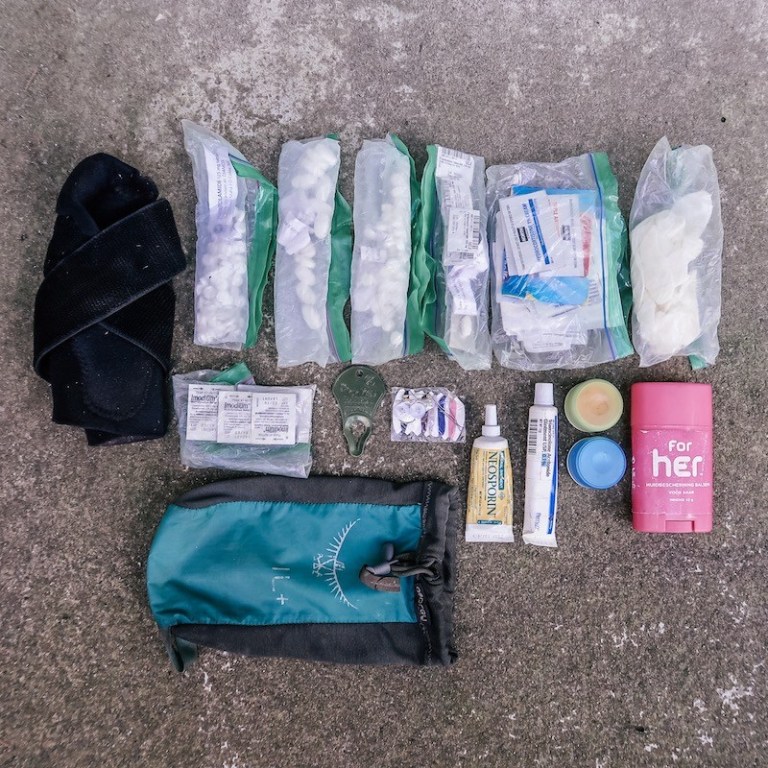
My Current Backcountry First-Aid Kit I Finished My Second PCT Thru-Hike With:
1L Osprey Ultralight Stretch Stuff Sack
1 lightweight, adjustable ankle brace (Replaced the one I gave away on trail last year)
1.5 oz Body Glide (anti-chafing stick) – I could lose some weight and get the 0.35 oz size but I found this one in a Hiker Box for free
Mini sewing kit (From a hotel I stayed at along the PCT)
0.5 oz. Neosporin
1 pair of latex gloves
Tick Key
Imodium (5 caplets)
Aleve (27 caplets) + humangear GoTubb container to store them in
Benadryl (24 tablets) + humangear GoTubb container to store them in
Blister Kit – 5 Band-Aids (regular size), 8 small pre-cut pieces of self-adhesive moleskin, 3 Antiseptic towelettes, 1 safety pin, 2 triple antibiotic ointment packets and a small roll of Leukotape
Flagyl for Giardia (Prescription Medication)
Diamox for altitude sickness (Prescription Medication)
Antibiotics for UTI (Prescription Medication)
Zithromax for sinus infection (Prescription Medication)
0.5 oz Kenalog topical ointment (Prescription ointment for poison oak)
Total Weight: 11.8 oz
Here’s the list of items I ditched since creating my backcountry first-aid kit over two years ago. Some of these items were either moved to a different system in my pack OR I decided to get rid of all together because I didn’t need them/never used them:
1 oz. Zanfel – I left it in a Hiker Box at Kennedy Meadows
1 oz calamine lotion – I left this in the Hiker Box at Kennedy Meadows along with the cute humangear GoToob Medium Squeeze Bottle I had it in
1 oz. Hand sanitizer – Moved to my toiletries bag
1 oz. SPF 50 sunscreen – Moved to my toiletries bag
2 oz. Desitin – Switched to Body Glide because I was tired of the white, sticky residue Desitin left behind
3 hot herbal patches, cut in half – I love these in off-trail life, but never used them on trail.
1 oz. New Skin liquid bandage – The glass container this came in wasn’t worth the weight
3 waterproof pad bandages
6 blister gel bandages
3 oval, textured blister bandages
1 Ace self-adhering elastic bandage
*I got rid of all the extra bandages and started using Leukotape instead, I kept a few various sized bandages and self-adhesive moleskin for my blister kit, just in case.
A Word About the Above Prescriptions…
One of the PCT thru-hikers I met when I started planning for my own hike gave me some great advice. She highly recommended I visit my doctor before getting on the trail and get a couple prescriptions to add to my backcountry first-aid kit. I thought this was a genius idea, especially since a majority of the PCT trail is located in remote areas. There’s no telling where the next medical center would be or how expensive it would be for a prescription of something while being out there.
The last five items listed in each of my kits (Flagyl, Diamox, Antibiotics for UTL, Zithromax and Kenalog topical ointment) are all prescriptions I got from my doctor. These will cover me in case I come down with stuff like Giardia (a parasite you can potentially get from drinking contaminated water), altitude sickness (I may or may not get traveling in high altitudes), a UTI (ladies, you feel me on this one) or a sinus infection (from traveling through cold and wet environments.) My doctor advised me on if I got an infection in my chest and it was accompanied by a fever, I should get off trail and seek medical condition instead of trying to treat the symptoms myself. Before adding any prescription medications to your first-aid kid, be sure to see a doctor first.
I hope you find this information helpful. Remember, everyone is unique and has different needs when traveling. What works for me, might not work for you. This post was written with the intent of inspiring you to put together a backcountry first-aid kit of your own. If you have any questions about what to put in a backcountry first-aid kit or about any of the items I’ve included in my kit, please leave your questions in the comments below. Happy, safe hiking!
Disclaimer: http://www.The-Hungry-Hiker.com is a participant in the Amazon Affiliate Links and Skimlinks Program, affiliate advertising programs designed to provide a means for sites to earn advertising fees by advertising and linking to Amazon.com and other affiliated sites at no cost to you. Please note, I only link to products and services I personally use and trust.
Inspired? Pin It!
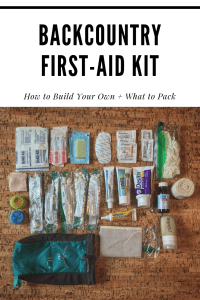

Great list! I’d also consider adding a tourniquet, 4-5 stronger pain killers (if you have any), and a gauze-type hemostatic dressing with a small roll of medical tape or small roll of duct tape wrapped around a pen or pencil. Hope you never need them, but if you do they can save your life or potentially the life of someone you meet.
Great suggestions!